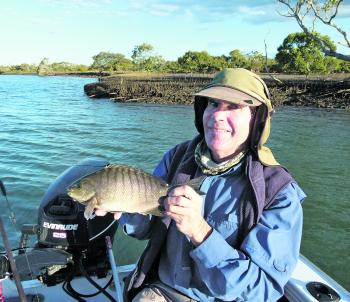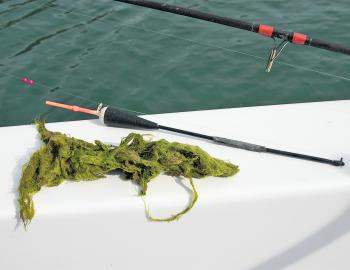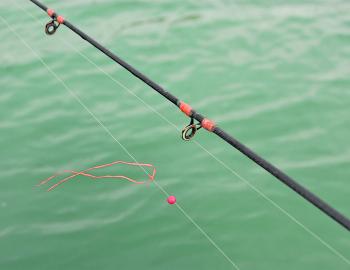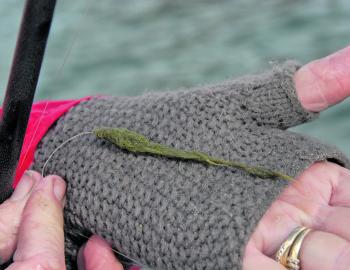September is a great month to catch some of those hard fighting, finicky biting (but great fun to catch) luderick. Few fish will repay a sloppy tackle set up with such indifference as a luderick, but if things are done right they aren’t hard to catch at all. And, because a float is used, there’s an element of sight fishing as well. In this article I’ll go through the usual float-and-fine-line system of taking luderick to make it easy for first timers to understand how the system works.
Luderick tend to inhabit areas where oceanic rocks are pounded by wave action and where marine growth such as fine stranded green weed and cabbage weed grow in abundance (cabbage weed is also green, and is often called sea lettuce). Luderick are always on the lookout for small sections of this marine growth torn loose by wave action, and they snap up these small morsels as they drift. These fish often move in close with a wave, then move back as it retreats. In all, they’re often very difficult places to fish safely!
While they are abundant around oceanic rock areas during late winter and early spring, they also form dense schools in estuaries and along river rock walls and other sunken features in order to spawn. That’s when we can take them safely.
Estuaries like Jumpinpin, parts of the Bribie Passage, rivers such as the Tweed, Brunswick, Richmond and the Clarence in NSW, as well as the rock walls of the Gold Coast Seaway have recognized luderick habitats. The boardwalk areas of Caloundra and the Tweed River also offer good numbers of fish set on spawning. Sometimes it seems there’s an almost equal number of anglers set on catching them.
Look for any area where deeper water (say, 2m+) runs along a sheer bank, such as a rock wall or mangrove-fringed mud bank, or against cover such as jetty pylons. These are the kinds of places luderick like to frequent.
Tackle involves using a soft tipped rod at least 3m long. This will ensure there’s a quick take up of slack line to set the hook, and will minimise pulled hooks. Luderick have very soft mouths so too solid a rod will see hooks pulling free during a spirited fight.
Most times quality 5kg mono or braid will form the main line, which is set up with a long stemmed but slim float to suspend the bait and indicate bites. The float isn’t fixed in position; it’s free to slide up and down. More on this shortly!
The main line, down past the free running float, is connected to a 1m long, 3kg hook trace of best quality fine line via a small swivel. When it comes to hooks, a no. 8 Mustad Needle Sneck is ideal.
To weight the float correctly so that only the stem shows above water, you can slide some small sinkers onto the main line above the swivel, while perhaps another small sinker plus a number of split shots are gently clamped onto the lighter hook trace.
If the float is extra buoyant it’s easy to glue some sheet lead on its stem to avoid having too much hardware on the line, which is prone to tangling. You’ll need to experiment to get this weighting system just right. Remember that too much float stem above water will allow the shy luderick to feel the float’s buoyancy as a slight resistance. If that happens, the fish will simply nip a bit off the bait and then leave it.
Most importantly, the float must drift at a selected depth not far off the bottom and exactly at the current speed. This will make the bait of green weed or cabbage growth look as though it’s drifting naturally in the current.
All this might sound simple enough, but it’s not always easy to achieve. Free running centrepin reels are ideal for this style of fishing but most anglers these days use threadline tackle with the bail arm at casting position. This allows the line to trickle off under control, at exactly current speed to avoid slack line, as the float wafts along in the current. When the ‘down’ occurs you flick the bail over and lift the rod to remove all slack and set the hook.
With a bait often drifting anywhere from 2.5-3.5m from the surface, it makes sense that the float must run freely on the line yet stop at a predetermined depth to ensure that the hook on its trace doesn’t go straight to the bottom and stop drifting. You can achieve this by tying a piece of dental floss or similar material onto the main line above the float and set at the pre-determined depth to fish.
This floss, or similar material, is referred to as a stopper. If the stopper was formed large enough the float’s top runner would certainly stop, right there, with the bait suspended right down under it. However, because float runners vary in size and a big fat stopper knot can move (and then change the desired fishing depth) if it jams in the rod’s tip runner, it’s best to put a very small bead on the line above the float so it will slide along as the float pushes it upwards until (a) the bead contacts the stopper and (b) the bead then stops the float’s movement. It’s a simple but effective method if setting correct fishing depth.
When you lower the rig into the water, the hook trace with its weight on it will quickly pull line through the runners of the float until the bead contacts the small bit of floss. Setting things up on the water usually involves drifting a little deeper each time by moving the floss stopper back towards the reel until you touch the bottom. Come back just a little and you have the ideal setup for a fish to confidently take a drifting bait.
This system makes it easy to control the depth being fished by moving the floss according to requirements. With a tide ebbing, gradually move the line stopper down towards the hook. On a rising tide it’s the opposite.
The easiest way of setting up this rig is to put everything together then tie on the slip of floss around 2-2.5m from the hook and drop the whole rig in the water to ensure the line slides down freely and the weights on the lower trace are set up to keep only the float’s stem showing.
When fishing, remember that luderick usually only bite when there’s some run in the tide. As the current slows, so does their feeding activity.
When it comes to bait, luderick are very fussy. Fresh green weed or fresh cabbage are impossible to beat, although they’re often hard to come by. It’s also a bit hard to keep a hard-won supply in good condition. Putting it in the freezer will cause such a pong you will only do it once. Besides, it goes very soft when thawed.
The refrigerator is not so bad, but by the end of a couple of days you won’t want to open that door either. Both weed and cabbage will keep for a short while – maybe up to one week – when wrapped loosely in a rag dampened with sea water, then again wrapped in newspaper to keep air away and placed in a cool spot away from sunlight and breeze.
Another method I employ is to layer the weed or cabbage in a quite shallow container full of sand with a layer of bait, a layer of sand, each in turn. Putting a tight lid on the container seems to keep the stuff fairly good for a couple of weeks. When removed from the sand and washed gently in seawater, the weed or cabbage will rejuvenate fairly well.
Putting on just the right amount of bait is important. A small section of cabbage can be folded several times until about the size of a 5 cent piece, then you push the hook through it again and again to secure it.
When using green weed, roll a small section of it on something like the palm of your hand or the leg of your fishing pants to form a small sliver around 10cm long and about as thick as a match. Double it around to form a U shape over the line at the top of the hook, and gently plait the alternate sides down the hook shank to form a tail around 3cm long under the bend. This tail helps the fish suck it straight in, and then down goes the float!
When you get a bite, wait around two seconds and set the hook. Don’t attempt to rush the fish in or the hook will tear loose and the panicking fish will spook his mates and the whole school will move to a safer area. Game over!
Luderick respond very well to berley. To make berley, finely chop some weed or cabbage into tiny particles then mix it with damp sand. You want small amounts of chopped weed or cabbage and plenty of sand.
When fishing from a boat you should have at least a couple of buckets of this sort of berley on hand. The idea is to make a small ‘bomb’ of berley in a cut-off kitchen detergent bottle, and drop it straight under the boat every few minutes or after each fish is caught.
A landing net is vital for these soft-mouthed fish, and once you’ve netted a fish you should immediately dispatch and bleed it before putting it into an ice slurry. That’s unless you’re going to keep it alive in a well or keeper net, in which case you should perform the same steps as soon as the fishing session is over. If you don’t bleed the fish and put it in a slurry, the eating quality is much reduced. These vegetarian fish can have a strong weed flavour if neglected.
When filleting you should immediately cut off any black gut lining. You’ll probably want to skin it too, because if you leave the skin on it can sometimes make the fillet curl in the pan and make cooking more difficult.
I like to use Tandaco Coating Mix for Lightly Seasoned Fish when I cook luderick. It’s great for these striped battlers because its mild flavour doesn’t overpower the slightly nutty flavour of fresh luderick.
Reads: 6665
The author with a Jumpinpin luderick.

Feeding line as the float drifts away keeps the bait at the correct depth to entice a fish. Note the sheer bank.

Layering in sand has kept some weed in reasonable condition. A gentle rinse in seawater should return it to usable status.

Note the appearance of the weed, which has been rinsed after removal from its layered bed of sand.

This line stopper was made from a section of onion bag. The small bead designed to contact the stopper and halt the float’s movement.

Forming a weed bait is easy when it’s gently rolled first to shape it.

A small sliver of green weed brought this fish undone.

That small section of black gut lining needs to be cut off the fillet to maintain eating quality.

This selection of weed and cabbage has been kept in a damp rag for about a week and should be OK when rinsed in seawater.




